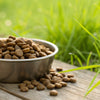Should You Soak Dry Dog Food? A Comprehensive Guide for Pet Owners
- Houndsy
Table of Contents
- Introduction
- Understanding Dry Dog Food
- Advantages of Soaking Dry Dog Food
- Disadvantages of Soaking Dry Dog Food
- Practical Steps for Soaking Dry Dog Food
- Reflecting on Your Dog Feeding Routine
- Conclusion
- FAQ Section
Introduction
Have you ever watched your dog struggle to chew their dry kibble, or perhaps they’ve had a few too many "oops" moments after eating too quickly? Many of us have experienced these scenarios, and they raise an important question: should you soak dry dog food? This question is relevant not just for pet owners with older dogs or puppies but for anyone looking to enhance their dog's dining experience.
As pet parents, we know that nutrition is vital for our furry friends, but the way we prepare their meals can significantly impact their health and happiness. Soaking dry dog food is a practice that has gained traction among dog owners, with many citing benefits such as improved digestion, hydration, and palatability. However, it’s essential to balance these advantages with potential drawbacks, such as nutrient loss and risks of bacterial growth.
By the end of this blog post, we’ll cover everything you need to know about soaking dry dog food. We will explore the advantages and disadvantages, when to soak, how long to soak, and practical tips for making the process seamless for you and your pup. Let’s dive in and discover whether soaking dry dog food could be the key to a healthier, happier mealtime for your canine companion.
Understanding Dry Dog Food
What is Dry Dog Food?
Dry dog food, often referred to as kibble, is a staple in many pet households due to its convenience, long shelf life, and cost-effectiveness. Typically composed of meat, grains, vegetables, and essential nutrients, kibble is formulated to meet a dog’s dietary needs.
Composition and Nutritional Value
Kibble is designed to be nutritionally balanced, providing proteins, fats, carbohydrates, vitamins, and minerals in a compact form. However, its hard texture can pose challenges for certain dogs, especially those with dental issues or sensitive stomachs.
Why Consider Soaking?
Soaking dry dog food involves adding warm water to the kibble to soften it before serving. This practice can make the food easier to chew, enhance its flavor, and increase hydration, making it particularly beneficial for dogs that struggle with dry kibble.
Advantages of Soaking Dry Dog Food
-
Enhanced Palatability
Soaking kibble can elevate its flavor and aroma, making mealtime more enticing for your dog. This is especially helpful for picky eaters or dogs that have lost their appetite. -
Improved Digestion
By softening the food, soaking can aid in digestion, particularly for dogs with sensitive stomachs or those recovering from illness. The moisture helps break down the food, making it gentler on the digestive system. -
Increased Hydration
Many dogs do not drink enough water, which can lead to various health issues. Soaking kibble provides an additional source of hydration, promoting overall health and well-being. -
Reduced Risk of Choking
Soaked food is easier to chew and swallow, which can lower the risk of choking, particularly for dogs that tend to gulp their meals. -
Support for Puppies and Senior Dogs
Young puppies transitioning from mother’s milk to solid food benefit from softened kibble, while older dogs with dental issues may find it easier to eat.
Disadvantages of Soaking Dry Dog Food
-
Potential Nutrient Loss
Prolonged soaking can lead to nutrient degradation, particularly with water-soluble vitamins. It’s crucial to monitor soaking times to maintain the food’s nutritional value. -
Bacterial Growth Risk
Leaving soaked kibble out for extended periods can create an environment for bacteria to thrive. To mitigate this risk, serve soaked food promptly and discard any leftovers after 15-30 minutes. -
Reduced Dental Benefits
While dry kibble can help scrape plaque from teeth, soaking may diminish this effect. Regular dental care, such as brushing, remains essential regardless of the food’s texture. -
Overeating Risks
Soaked food is easier to consume, which may lead to overeating, especially in dogs that already have a tendency to gobble their meals.
Practical Steps for Soaking Dry Dog Food
Recommended Soaking Times
- For Puppies: Soak kibble for 15-30 minutes to ensure it is soft enough for young teeth.
- For Adult Dogs: A soaking time of 15-20 minutes is usually sufficient.
- For Senior Dogs: Depending on their dental health, soaking for 20-30 minutes is beneficial.
Tips for Effective Soaking
-
Use Warm Water
Warm water (about 30-40 degrees Celsius) is ideal as it helps the kibble absorb moisture more efficiently. -
Monitor Consistency
After soaking, check the texture of the kibble. It should be soft enough to break apart easily but not mushy. -
Avoid Over-Soaking
Do not leave soaked food out for more than 30 minutes to prevent bacterial growth. -
Prepare in Advance
If you need to prepare food in advance, consider soaking overnight in the refrigerator.
Example Feeding Routine
- Morning: Soak kibble in warm water while you take your dog for a walk. By the time you return, the food will be ready.
- Evening: Prepare a fresh batch of soaked kibble for dinner, ensuring to monitor the time to prevent bacterial growth.
Reflecting on Your Dog Feeding Routine
As we consider our dog feeding routines, it’s essential to think about how small changes can make a significant difference in our pets’ lives. Have you noticed your dog struggling with dry kibble? Are they eating too quickly? Soaking their food could be the answer.
At Houndsy, we understand that pet care is about more than just feeding; it’s about enhancing the experience and ensuring the well-being of our furry friends. Our flagship product, the Houndsy Kibble Dispenser, is designed to simplify feeding while maintaining the quality and aesthetics of your home. With features like perfect portion control and a stylish mid-century modern design, we aim to elevate the daily feeding ritual.
To explore how we can enhance your pet's feeding experience, check out the Houndsy Kibble Dispenser.
Conclusion
Soaking dry dog food can be a game-changer for both your dog’s health and your everyday feeding routine. By understanding how long to soak dry dog food and the benefits it offers, you can make informed decisions that enhance your pet’s dining experience. Remember to monitor soaking times, use warm water, and pay attention to your dog's individual needs.
As you consider these insights, we encourage you to try soaking your dog’s kibble and observe any changes in their eating habits or overall health. At Houndsy, we believe that small adjustments can lead to significant improvements in the lives of our furry companions.
FAQ Section
-
How long should I soak dry dog food?
Typically, 15-30 minutes is recommended, depending on the dog's age and health. -
Can I soak dry dog food overnight?
Yes, you can soak kibble overnight in the refrigerator to prepare for the next meal. -
What type of water should I use for soaking?
Use warm water (30-40 degrees Celsius) to facilitate better absorption. -
Is it safe to leave soaked food out for too long?
Soaked food should not be left out for more than 15-30 minutes to prevent bacterial growth. -
Does soaking dry food affect its nutritional value?
Moderate soaking can enhance digestibility, but prolonged soaking may lead to nutrient loss. -
Should all dogs have their food soaked?
Soaking is beneficial for puppies, senior dogs, or those with health issues. Consult your veterinarian for specific advice.
For more insights and tips on pet care, don’t forget to explore our Houndsy Kibble Dispenser and transform your feeding routine!












